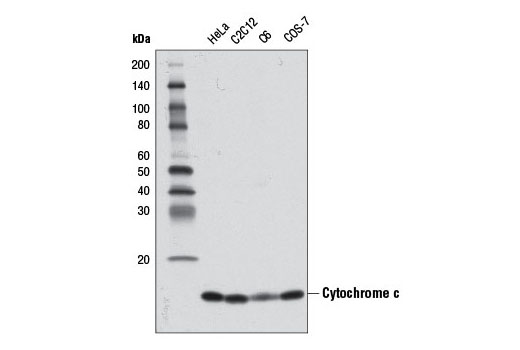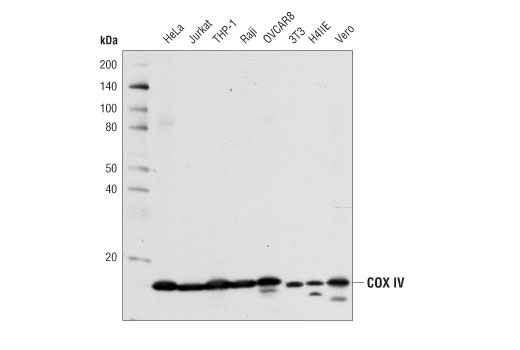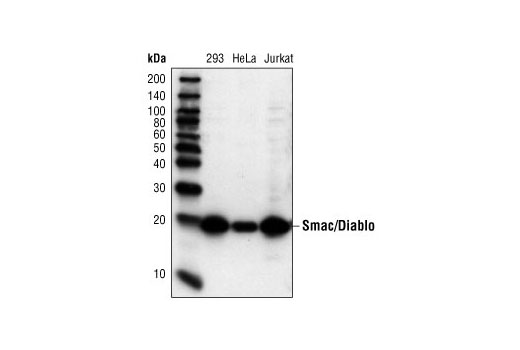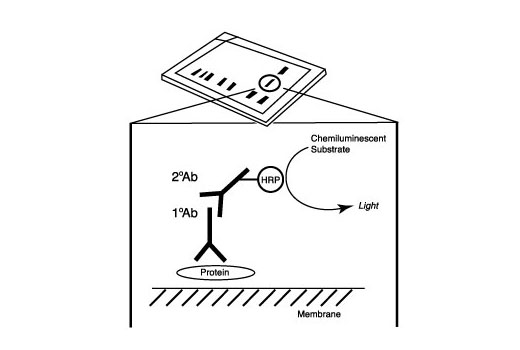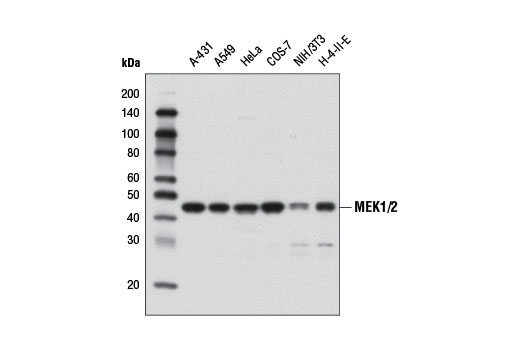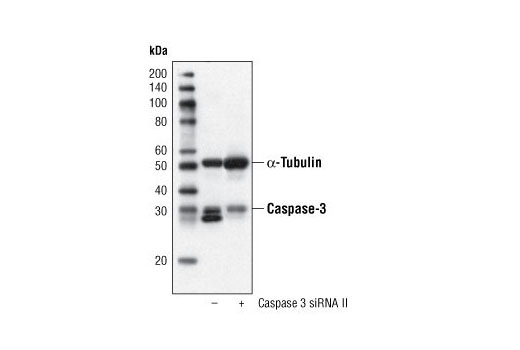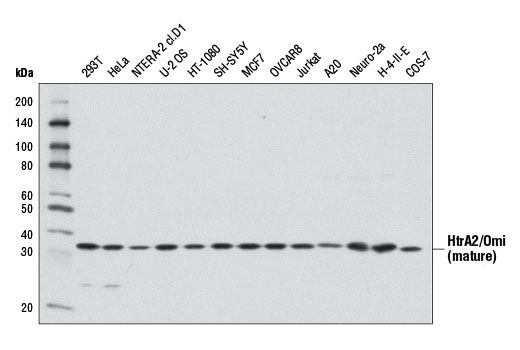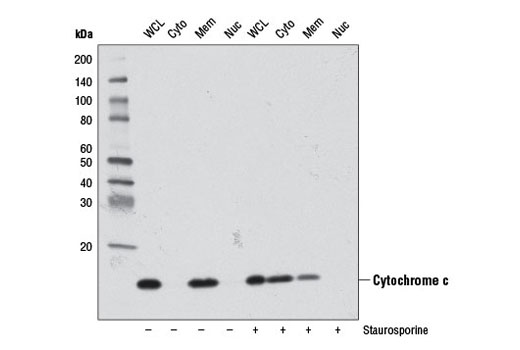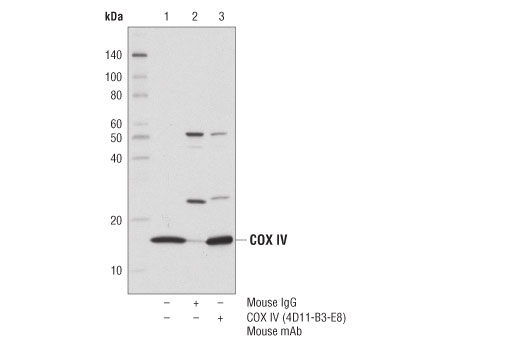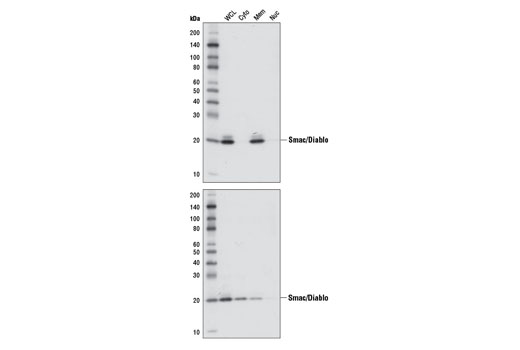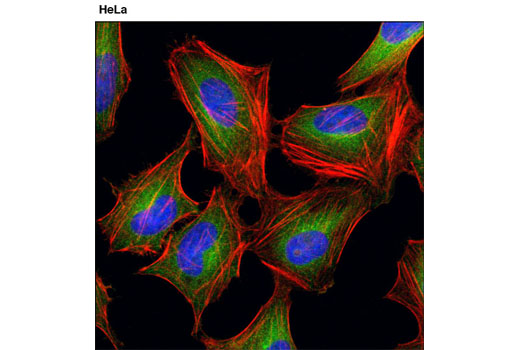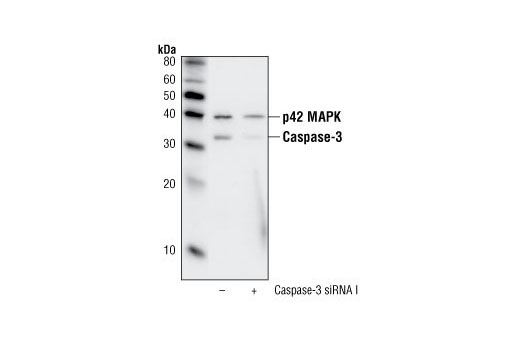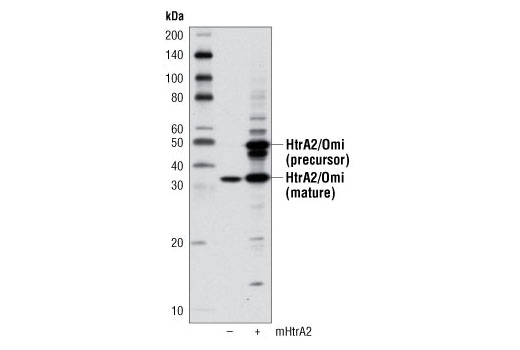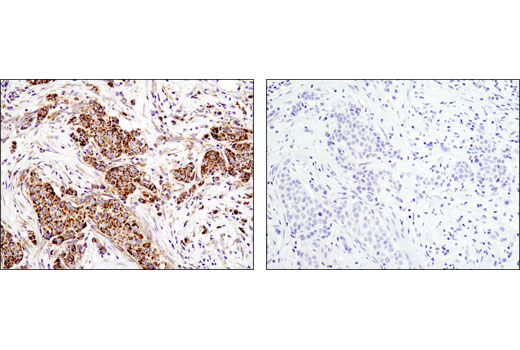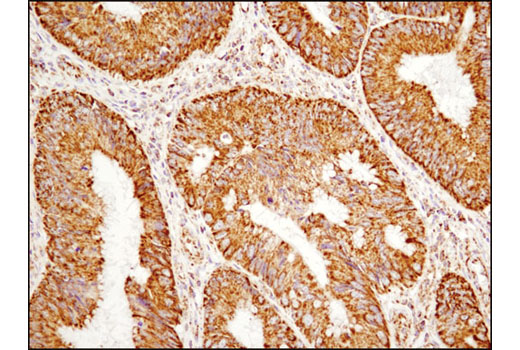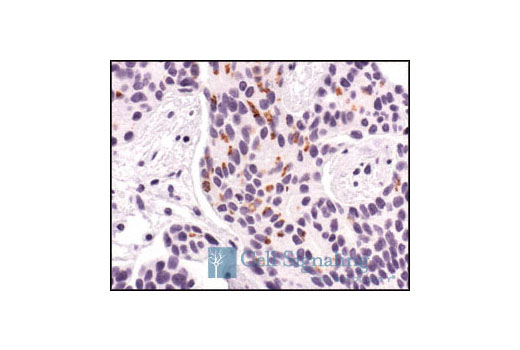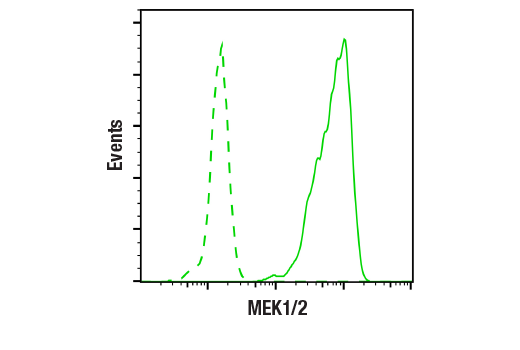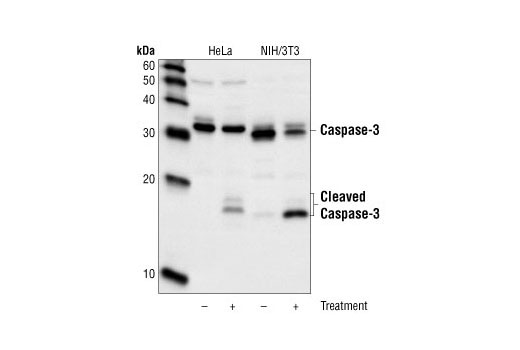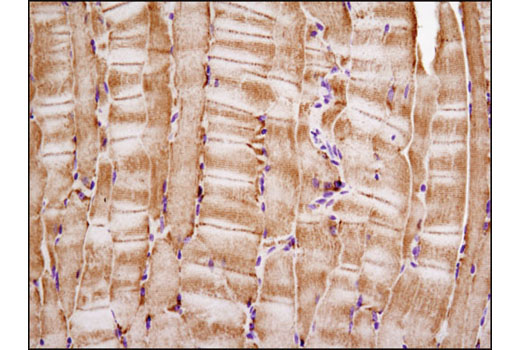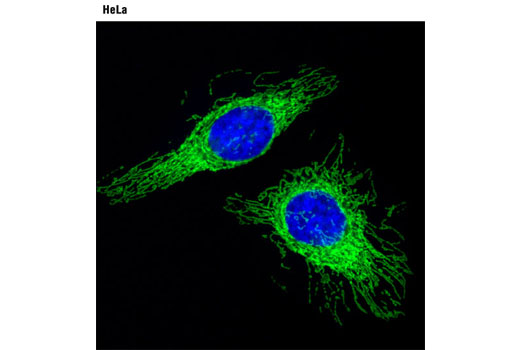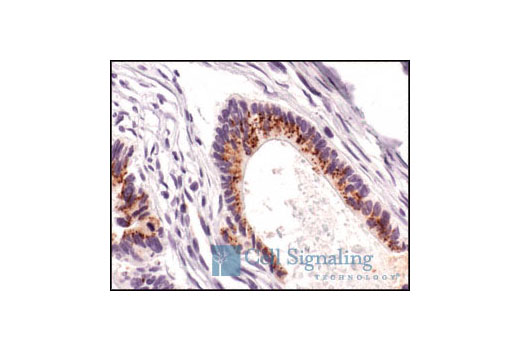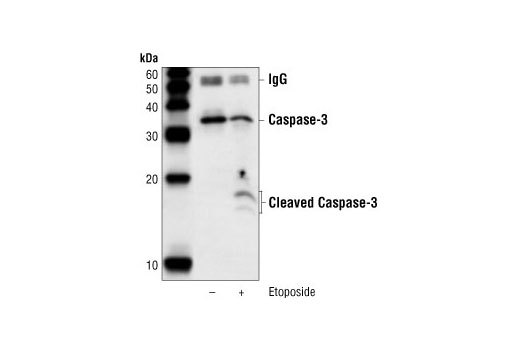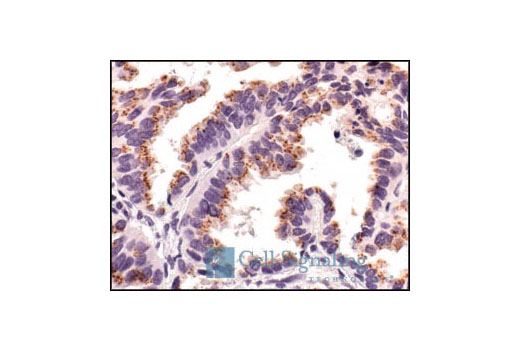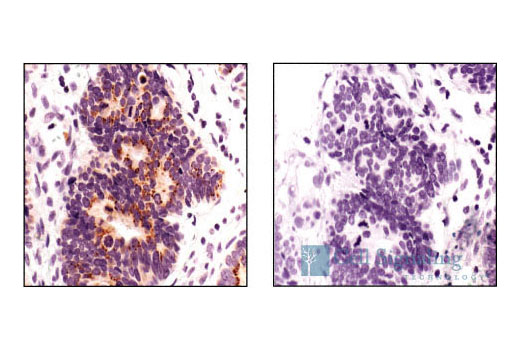| Product Includes | Product # | Quantity | Mol. Wt | Isotype/Source |
|---|---|---|---|---|
| Cytochrome c (D18C7) Rabbit mAb | 11940 | 40 µl | 14 kDa | Rabbit IgG |
| Smac/Diablo (79-1-83) Mouse mAb | 2954 | 40 µl | 21 kDa | Mouse IgG |
| HtrA2/Omi (D20A5) Rabbit mAb | 9745 | 40 µl | 36 kDa | Rabbit IgG |
| Caspase-3 (8G10) Rabbit mAb | 9665 | 40 µl | 17, 19, 35 kDa | Rabbit IgG |
| COX IV (4D11-B3-E8) Mouse mAb | 11967 | 40 µl | 17 kDa | Mouse IgG1 |
| MEK1/2 (D1A5) Rabbit mAb | 8727 | 40 µl | 45 kDa | Rabbit IgG |
| Anti-rabbit IgG, HRP-linked Antibody | 7074 | 100 µl | Goat | |
| Anti-mouse IgG, HRP-linked Antibody | 7076 | 100 µl | Horse |
Please visit cellsignal.com for individual component applications, species cross-reactivity, dilutions, protocols, and additional product information.
Description
The Apoptotic Release Antibody Sampler Kit provides an economical means to evaluate targets that are released from the mitochondria with apoptotic stimuli. The kit contains enough primary antibody to perform four western blots per primary antibody.
Storage
Background
Apoptosis is a regulated physiological process leading to cell death. Caspases, a family of cysteine acid proteases, are central regulators of apoptosis. Initiator caspases (including 8, 9, 10, and 12) are closely coupled to proapoptotic signals. Once activated, these caspases cleave and activate downstream effector caspases (including 3, 6, and 7), which in turn cleave cytoskeletal and nuclear proteins like PARP, α-fodrin, DFF, and lamin A, and induce apoptosis (1).
Cytochrome c is a well conserved electron-transport protein and is part of the respiratory chain localized to the mitochondrial intermembrane space (2). Upon apoptotic stimulation, cytochrome c released from mitochondria associates with procaspase-9 (47 kDa)/Apaf-1. This complex processes caspase-9 from inactive proenzyme to its active form (3). This event further triggers caspase-3 activation and eventually leads to apoptosis (4).
Smac/Diablo is a 21 kDa mammalian mitochondrial protein that functions as a regulatory component during apoptosis (5,6). Upon mitochondrial stress, Smac/Diablo is released from mitochondria and competes with caspases for binding of inhibitor of apoptosis proteins (IAPs) (5,6). The interaction of Smac/Diablo with IAPs relieves the inhibitory effect of the IAPs on caspases (7,8).
High temperature requirement protein A2 (HtrA2)/Omi is a serine protease with homology to the E. coli HtrA protein (DegP) and is thought to be involved in apoptosis and stress-induced degradation of misfolded proteins (9). HtrA2 is produced as a 50 kDa zymogen that is cleaved to generate a 36 kDa mature protein that exposes an amino terminal motif (AVPS) resembling that of the IAP inhibitor Smac/Diablo (10-14). Like Smac, interaction between HtrA2 and IAP family members, such as XIAP, antagonizes their inhibition of caspase activity and protection from apoptosis (10-14).
Caspase-3 (CPP-32, Apoptain, Yama, SCA-1) is a critical executioner of apoptosis, as it is either partially or totally responsible for the proteolytic cleavage of many key proteins, such as the nuclear enzyme poly (ADP-ribose) polymerase (PARP) (15). Activation of caspase-3 requires proteolytic processing of its inactive zymogen into activated p17 and p12 fragments. Cleavage of caspase-3 requires the aspartic acid residue at the P1 position (16).
Cytochrome c oxidase (COX) is a hetero-oligomeric enzyme consisting of 13 subunits localized to the inner mitochondrial membrane (17-19). It is the terminal enzyme complex in the respiratory chain, catalyzing the reduction of molecular oxygen to water coupled to the translocation of protons across the mitochondrial inner membrane to drive ATP synthesis. The 3 largest subunits forming the catalytic core are encoded by mitochondrial DNA, while the other smaller subunits, including COX IV, are nuclear-encoded. The COX IV (4D11-B3-E8) Mouse mAb can be used effectively as a mitochondrial loading control in cell-based research assays.
MEK1 and MEK2, also called MAPK or Erk kinases, are dual-specificity protein kinases that function in a mitogen activated protein kinase cascade controlling cell growth and differentiation (20-22). Activation of MEK1 and MEK2 occurs through phosphorylation of two serine residues at positions 217 and 221, located in the activation loop of subdomain VIII, by Raf-like molecules. MEK1/2 is activated by a wide variety of growth factors and cytokines, as well as by membrane depolarization and calcium influx (20-23). MEK activates p44 and p42 MAP kinase by phosphorylating both threonine and tyrosine residues at sites located within the activation loop of kinase subdomain VIII. The MEK1/2 (D1A5) Rabbit mAb can be used effectively as a cytoplasmic loading control in cell-based research assays.
- Budihardjo, I. et al. (1999) Annu Rev Cell Dev Biol 15, 269-90.
- Schägger, H. (2002) Biochim Biophys Acta 1555, 154-9.
- Li, P. et al. (1997) Cell 91, 479-89.
- Liu, X. et al. (1996) Cell 86, 147-57.
- Du, C. et al. (2000) Cell 102, 33-42.
- Verhagen, A.M. et al. (2000) Cell 102, 43-53.
- Srinivasula, S.M. et al. (2001) Nature 410, 112-6.
- Srinivasula, S.M. et al. (2000) J Biol Chem 275, 36152-7.
- Gray, C.W. et al. (2000) Eur J Biochem 267, 5699-710.
- Suzuki, Y. et al. (2001) Mol Cell 8, 613-21.
- Hegde, R. et al. (2002) J Biol Chem 277, 432-8.
- Martins, L.M. et al. (2002) J Biol Chem 277, 439-44.
- van Loo, G. et al. (2002) Cell Death Differ 9, 20-6.
- Verhagen, A.M. et al. (2002) J Biol Chem 277, 445-54.
- Fernandes-Alnemri, T. et al. (1994) J Biol Chem 269, 30761-4.
- Nicholson, D.W. et al. (1995) Nature 376, 37-43.
- Ostermeier, C. et al. (1996) Curr Opin Struct Biol 6, 460-6.
- Capaldi, R.A. et al. (1983) Biochim Biophys Acta 726, 135-48.
- Kadenbach, B. et al. (2000) Free Radic Biol Med 29, 211-21.
- Crews, C.M. et al. (1992) Science 258, 478-80.
- Alessi, D.R. et al. (1994) EMBO J 13, 1610-9.
- Rosen, L.B. et al. (1994) Neuron 12, 1207-21.
- Cowley, S. et al. (1994) Cell 77, 841-52.
Background References
Trademarks and Patents
使用に関する制限
法的な権限を与えられたCSTの担当者が署名した書面によって別途明示的に合意された場合を除き、 CST、その関連会社または代理店が提供する製品には以下の条件が適用されます。お客様が定める条件でここに定められた条件に含まれるものを超えるもの、 または、ここに定められた条件と異なるものは、法的な権限を与えられたCSTの担当者が別途書面にて受諾した場合を除き、拒絶され、 いかなる効力も効果も有しません。
研究専用 (For Research Use Only) またはこれに類似する表示がされた製品は、 いかなる目的についても FDA または外国もしくは国内のその他の規制機関により承認、認可または許可を受けていません。 お客様は製品を診断もしくは治療目的で使用してはならず、また、製品に表示された内容に違反する方法で使用してはなりません。 CST が販売または使用許諾する製品は、エンドユーザーであるお客様に対し、使途を研究および開発のみに限定して提供されるものです。 診断、予防もしくは治療目的で製品を使用することまたは製品を再販売 (単独であるか他の製品等の一部であるかを問いません) もしくはその他の商業的利用の目的で購入することについては、CST から別途許諾を得る必要があります。 お客様は以下の事項を遵守しなければなりません。(a) CST の製品 (単独であるか他の資材と一緒であるかを問いません) を販売、使用許諾、貸与、寄付もしくはその他の態様で第三者に譲渡したり使用させたりしてはなりません。また、商用の製品を製造するために CST の製品を使用してはなりません。(b) 複製、改変、リバースエンジニアリング、逆コンパイル、 分解または他の方法により製品の構造または技術を解明しようとしてはなりません。また、 CST の製品またはサービスと競合する製品またはサービスを開発する目的で CST の製品を使用してはなりません。(c) CST の製品の商標、商号、ロゴ、特許または著作権に関する通知または表示を除去したり改変したりしてはなりません。(d) CST の製品をCST 製品販売条件(CST’s Product Terms of Sale) および該当する書面のみに従って使用しなければなりません。(e) CST の製品に関連してお客様が使用する第三者の製品またはサービスに関する使用許諾条件、 サービス提供条件またはこれに類する合意事項を遵守しなければなりません。
